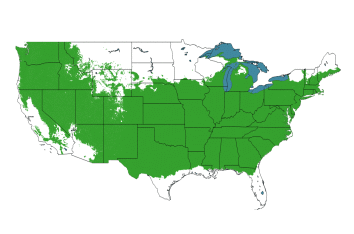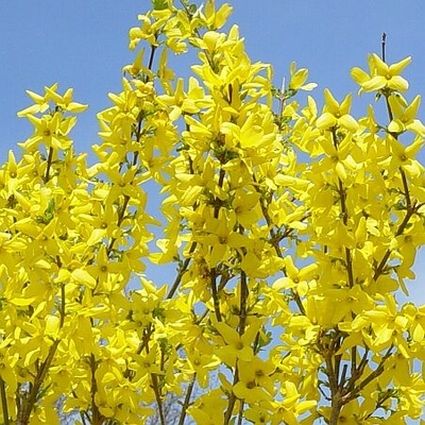✖
Lynwood Gold Forsythia
Forsythia 'Lynwood'
As low as
$56.64
In stock
SKU
PFY-645
Lynwood Gold Forsythia Brightens Early Spring
- Bright Yellow Flowers
- One of the First Shrubs to Bloom in Early Spring
- Fast Growing
- Wonderful, Easy Care
- Hedge or Privacy Shrub
- Fabulous Specimen Plant
- Great for Cut Flowers
- Adaptable and Hardy
After a long, cold winter, you crave color just as much as you do warmer weather. That's why people herald the electric yellow blooms of the Lynwood Gold Forsythia (Forsythia x intermedia Lynwood Variety') as a sure sign that spring is here again.
What a visual treat after a dreary winter! Gift yourself and your community with one or more of these really special plants.
Yes, these are the yellow flowering plants you see around town!
Forsythias are typically one of the very first plants to bloom in spring... and bloom they do! With larger blooms than other varieties, Lynwood Gold Forsythia is one of the showiest of all spring flowering plants.
Along with Robins and Daffodils, you'll know spring has arrived once the Lynwood Gold Forsythia begins to show sweet clusters of bell-shaped, lemon yellow flowers. The flowers last nearly 2 weeks.
The show is even more incredible, because the bright yellow flowers appear along the entire length of each branch. They appear before the new green leaves, so you'll really notice this welcome display.
People can—and do—trim these into tidy formal hedges. You can certainly shape it into a pretty oval or sphere shape. Another pleasing option is to allow them enough space to grow as free-form shrubs.
The overall shape of a natural Lynwood is very graceful. With naturally upright branches that cascade up and out into an arching shape, the growth habit of an untrimmed Lynwood Gold Forsythia is truly stunning.
In summer, you'll appreciate the dark green foliage. This is an easy care shrub that requires little maintenance beyond pruning if you'd like to keep it smaller.
This fast-growing plant can handle some occasional drought once it's established in your soil. Give it plenty of space to reach its full height and spread. Let it grow up and out, as it will to provide welcome privacy and screening.
During the fall, the leaves can turn yellow with a reddish purple tint, although this will vary from year to year. Partner them with Burning Bushes for a dynamic environment in both spring and fall. Even the bare, arching branches have visual appeal in wintertime.
If you need to punch up your springtime landscape, order this popular variety for your landscape today!
How to Use Lynwood Gold Forsythia in the Landscape
This adaptable shrub can be used throughout your landscape in many different ways. Give it enough room and it will become a beautiful focal point for you.
Why not create a magnificent free-form, flowering hedge along the length of your property or street? Everyone will thank you for the bold spring blooms.
Plant them 5 feet apart on center to create a solid flowering screen. You'll measure from the center of one to the center of the next plant.
Easily add privacy on a patio by including a few in a wide, patio planting bed. They are a natural partner for spring bulbs, including Daffodils, Hyacinth and Tulips. Add Peonies and Iris to extend the blooms.
Use a single plant as a specimen in the lawn to really make an impact. The two-inch long bell-shaped golden flowers will gild your landscape. Keep it untrimmed and allow the graceful branches to sweep up and out.
Use several of them along the length of a garden border. They make a wonderful backdrop for smaller plants. Increase the spacing to 10 feet apart if you want each plant to read as an individual.
Create outdoor rooms with this easy-care shrub as living walls. How fun to boost your use of your backyard with a private retreat!
If you have a slope that is too steep to mess with, use Lynwood Gold in a mass planting. Simply use a zig-zag planting pattern and plant them 5 feet apart on center.
Another wonderful feature of Forsythia is that you can force the budded branches to bloom indoors in late winter. Don't miss out on one of life's simple pleasures! It's easy and so fun to watch the blooms emerge.
To force the branches, watch for the swelling buds in late winter. Cut several branches and bring them indoors. Place them in a vase with warm water to get them started. Change the water daily. In a few days, the buds open with a bright yellow flower that will bring spring into your home.
#ProPlantTips for Care
A hybrid Forsythia, Lynwood Gold will tolerate a certain amount of partial shade. However, if it doesn't receive at least 6 hours of sunlight a day, it won't flower as well. Take care to ensure you provide a full sun location with as much exposure to morning sun as possible.
Remember that the flowers bloom on last year's growth. The best time to do any pruning on all Forsythia is right after the flowers have faded.
At this time, plan to cut back the largest, oldest stems all the way to the ground each year after the flowers are done. This will open up the plant to sunlight and air circulation. Remove low growing branches that hug the ground, too.
You'll love seeing the rewards of your labor next spring, when more flowers appear all over the open, airy, arching plant, including the center.
To create a hedge, open the plant up as above, and plan to tip prune in spring. You'll tidy up the line in late summer but take care not to trim too much or you'll sacrifice the beautiful spring flowers. Keep the line straight using a string line. A hedge should be trimmed with a narrow crown and wider base to allow the best sun penetration.
Keep a Lynwood Gold hedge a bit longer than a Boxwood or Privet hedge. Free-form living fences look magnificent, too.
As your Lynwood Gold Forsythia ages, you may want to do a renewal prune to perk it up after many years. Cut each cane directly to the ground right after flowering. It sounds drastic but have no fear. The plant will respond with lots of new growth from the ground and still make flower buds for next year.
Simple and easy to grow, these hardy plants create large, rounded shrubs quickly. The Forsythia grows best in well drained soils but will adapt to almost any soil type.
Water regularly to get established and less frequently when established, except during extreme drought. The plants prefer a soaker hose applying water to their roots, rather than a sprinkler or hose dripping water from overhead on its dark green leaves.
For best results, provide a mulch to maintain a cool rootzone. Organic low nitrogen fertilizer applied in the spring can help to maintain soil fertility. Try Dr. Earth Life Organic and Natural All-Purpose Fertilizer.
The plant has few problems and tolerates urban pollution. Flowers can be affected in unusually extreme late winter cold periods which can occur in zones 5 through 7. However, the lower branches may still bloom that season if the buds were protected by a layer of snow.
First discovered in Northern Ireland in 1935 at the Lynwood Gardens, it is just an observant eye that caught the unique differences of the Lynwood Gold, growing as a single limb off of the variety called Forsythia X intermedia Spectabilis'.
Known as a limb sport, the plants larger bright yellow blooms appearing before any green foliage made the limb standout in the garden. This variety quickly became a popular landscape shrub throughout Europe.
For a spectacular splash of color that signals the arrival of spring, you can't go wrong with the Lynwood Gold Forsythia. Order yours today!
| Botanical Name | Forsythia 'Lynwood' |
|---|---|
| Mature Height | 6 - 8 feet |
| Mature Spread | 8 - 10 feet |
| Soil Type | Widely Adaptable |
| Moisture | Low |
| Sun Exposure | Full Sun, Partial Shade |
| Growth Rate | Fast |
| Bloom Period | Early Spring |
| Flower Color | Yellow |
| Foliage Color | Green |
| Fall Color | Yellow |
| Pollinator Required | No |
| Pollinator Friendly | Yes |
| Growing Zone Range | 5-8 |

Write Your Own Review

